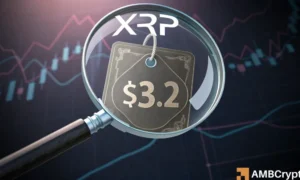The Security Risks of Unencrypted GEO Satellite Downlinks: Implications for Bitcoin Miners and the Crypto Industry
Recent research highlighted by UC San Diego (UCSD) and the University of Maryland has revealed alarming vulnerabilities in the realm of global satellite communications. Approximately half of Geostationary Operational Environmental (GEO) satellite downlinks transmit data without encryption, making them susceptible to interception with readily available consumer hardware costing as little as $800. The study, which was presented in a paper titled “Don’t Look Up” at CCS 2025 in Taipei, underscored the significant threats from unencrypted satellite links, particularly in the context of Bitcoin mining and cryptocurrency transactions.
These findings are not merely theoretical; they involve a practical examination of various types of sensitive data, including telecommunications backhaul traffic, industrial control systems, and even law enforcement communications. While the authors reached out to affected providers to inform them of these vulnerabilities, the implications extend beyond those specific cases. The research highlights a growing concern regarding the legacy systems still in place, which were not designed with current standards of cybersecurity in mind.
The Risks of Bitcoin Operations Over GEO Satellites
For Bitcoin miners functioning in remote areas, the implications of this research are significant. The primary connection protocol for Bitcoin miners to pools is Stratum, which often operates over unencrypted TCP connections unless Transport Layer Security (TLS) is explicitly enabled. This means that critical miner identifiers, job templates, and transaction information can be intercepted easily when transmitted over these insecure links. Moving to Stratum V2, which employs authenticated encryption by default to bolster security, is recommended. However, many operators still rely on older systems that may be vulnerable.
While Blockstream Satellite exists to transmit public Bitcoin block data through a one-way downlink and enables encrypted message support, it is not without risks. Operators relying solely on GEO backhaul to transmit sensitive operational data may compromise their system’s integrity if encryption is overlooked. As the Bitcoin landscape evolves and hash rates fluctuate, the potential for a heightened risk exposure remains.
Understanding the Current Economic Landscape
Profitability is a pressing concern for current Bitcoin miners. As of late September, hashrate hovered around 1.22 ZH/s with estimates of hashprice around $51 per petahash (PH) per day. The findings highlight the need for secure transport mechanisms, particularly given that the largest expense tied to implementing transport encryption is often engineering hours rather than new hardware. With the demand for cost-effective solutions, operators must prioritize security while keeping an eye on expenses.
The research offers a sensitivity model that illustrates the potential risks surrounding unencrypted Stratum V1 operations. Depending on how many miners are operating over GEO backhaul and still using unencrypted links, the vulnerability levels shift dramatically. Scenarios painted range from minimal exposure to catastrophic risk, indicating a pressing need for network security strategies that prioritize TLS adoption.
Implementing Effective Security Measures
The research also provides operational guidance for mitigation efforts centered around securing Stratum endpoints. Key recommendations include mandating TLS across all V1 endpoints while transitioning to Stratum V2 for new connections. The process would entail employing translation proxies for older rigs that are unable to directly adopt Stratum V2. With low overhead costs associated with these changes, most mining operators would benefit significantly from this shift.
Beyond endpoint security, it’s vital to monitor share patterns and endpoint behavior actively. By disabling insecure interfaces on satellite modems and applying robust encryption strategies, operators can safeguard their data against interception. Implementing these measures promptly will help in aligning with better security practices, which are crucial now that vulnerabilities in GEO satellite communications have been documented.
Navigating the Future of Cryptography in Satellite Operations
As we move into the next year, the landscape will demonstrate how quickly and effectively pools and miners can transition to encrypted transport protocols. The first path to securing operations involves default encryption, where pools actively accept V1 connections only over TLS. The alternative poses a less favorable scenario where a significant number of operations may still be left unencrypted, lending opportunities for opportunistic attacks.
Moreover, the risk of stagnation can arise if organizations resist adapting their protocols, trusting in obscurity as a defense. Given the research supporting the simplicity of implementing robust encryption measures, the need for immediate adaptation is critical. This poses a dilemma for operators, especially in light of confusion between Blockstream Satellite’s functionality and the actual connection security for Bitcoin miners.
Protection for Node Operators
Unlike miners, node operators (or “noderunners”) have a different set of risks. While they generally handle public blockchain data, reliance on GEO satellite backhaul can still lead to exposure risks. Although relaying public data does not involve sharing sensitive credentials, node operators remain vulnerable to eavesdropping and spoofing if encryption is not employed. Tools such as Tor and VPNs can be advantageous in enhancing confidentiality, but some basic security practices involving encrypted management interfaces and network connections should still be in place.
In summary, the crucial findings from UCSD and UMD regarding unencrypted GEO satellite downlinks illustrate significant vulnerabilities that cryptocurrency miners and node operators must confront. Encouraging immediate action towards encryption methodologies, particularly in the transmission of sensitive data, will help fortify the operations against potential attacks. With rising hash rates and competitive pressures, adopting security practices through TLS and migrating to Stratum V2 will not just enhance operational security; it could very well be a determining factor in maintaining the integrity of the broader cryptocurrency network.

















